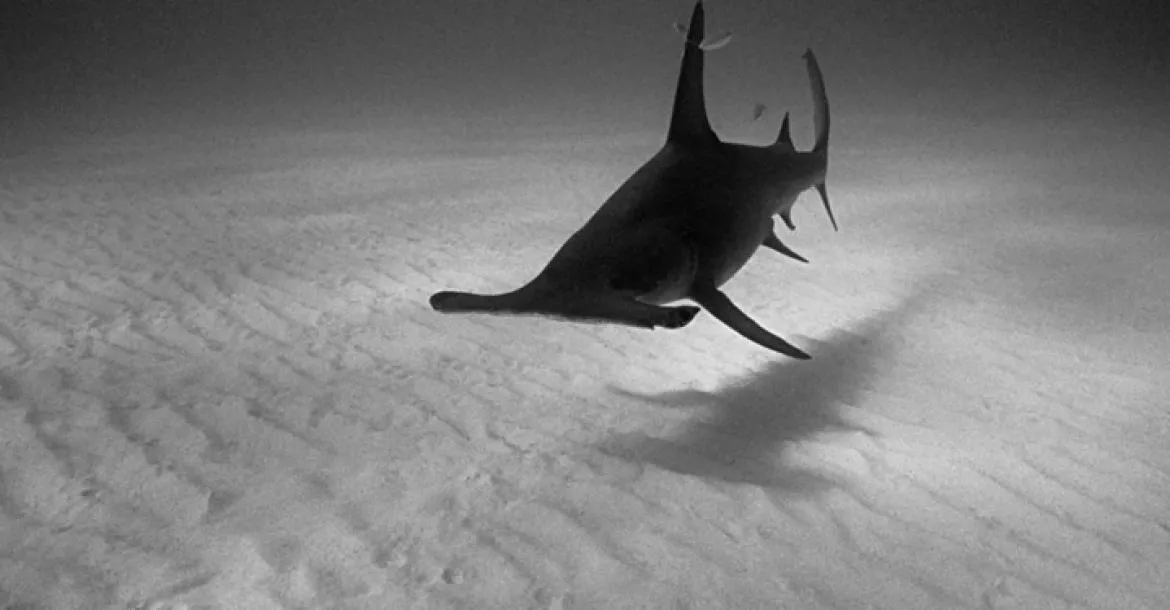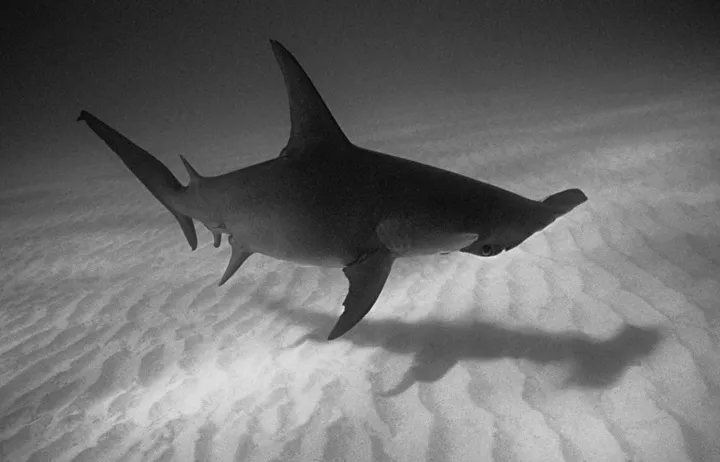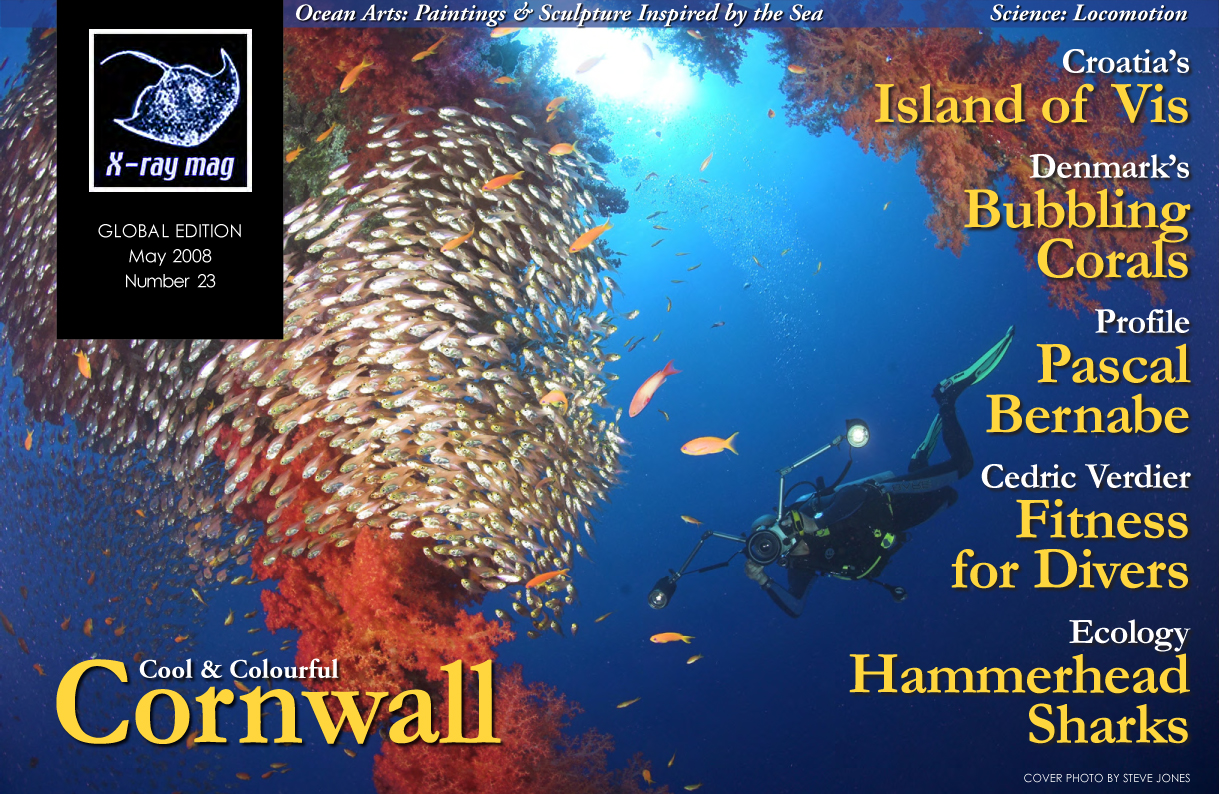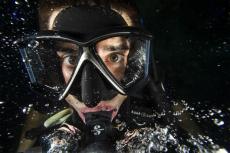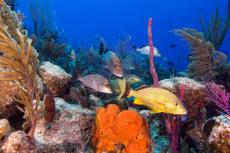Why the peculiar head shape of the hammerhead shark developed as it did has been the subject of much speculation. Few other morphological oddities have inspired so many fanciful and sensible theories about its function as the weirdly shaped head that characterises the hammerhead shark. Recent experimental evidence supports some ideas and refutes others, while pointing to a previously unsuspected role for this peculiar feature.
Contributed by
Why the peculiar head shape of the hammerhead shark developed as it did has been the subject of much speculation. Few other morphological oddities have inspired so many fanciful and sensible theories about its function as the weirdly shaped head that characterises the hammerhead shark. Recent experimental evidence supports some ideas and refutes others, while pointing to a previously unsuspected role for this peculiar feature.
All nine known species of hammerhead sharks have a projection on each side of the head that gives it a resemblance to a flattened hammer with the eyes and nostrils of the shark being positioned at the tips of the extensions.
The persistence of this unique head shape, which has been termed the cephalofoil in recognition of its wing-like appearance over the past 20-25 million years and its presence in several hammerhead shark species of diverse head morphologies, tell of its evolutionary success. Several hypotheses are proposed to explain the evolution of the cephalofoil, but few have been empirically tested.
There are two main lines of thought about the function of this peculiar feature. One advocates that it improves sensory perception, the other that is provides the shark with hydrodynamic advantages such as extra lift or maneuverability.
Hammerheads are notably one of the only creatures in the animal kingdom to acquire a tan from prolonged exposure to sunlight, a feature shared by pigs and humans. Tanning occurs when a hammerhead is in shallow waters or close to the surface for long periods.
Supersenses
Hammerheads are aggressive predators but have disproportionately small mouths and seem to do a lot of bottom-hunting for fish, rays, cephalopods, and crustaceans. A favorite meal of the hammerheads is the stingray.
The sensory hypotheses focus on the advantages of widely spaced eyes for enhanced binocular vision, nostrils for better tracking of odours and more precise detection of the electric currents generated by potential prey. Sharks are equipped electrically sensitive organs on their heads known as ampullae of Lorenzine. These ampullae, which appear as hundreds of minute dark pores in the skin, enable the animal to detect the minute electrical fields produced by muscles in prey that have perhaps burrowed under the sand of the seabed.
Hammerheads can sweep for prey more effectively. By distributing the receptors over a wider area—across the flat and broad heads—the search area for this electrosensory capability is maximized thereby increasing the opportunity to detect food sources.
The resemblance of the cephalofoil to a metal detector springs to mind. To maintain a comparable spatial resolution of small, prey-generated electric fields there is a corresponding increase in the number of electrosensory pores over the wider head area.
These sharks have been able to detect an electrical signal of half a billionth of a volt. The sharks can even discern between the two kinds of electric fields: the DC field that results from the osmotic potential between the prey’s body tissue and seawater, and the AC fields generated by the contraction of the prey’s muscles.
The hammer-shaped head also gives these sharks larger nasal tracts, increasing the chance of finding a particle in the water by at least ten times the ability of other ‘classical’ sharks.
Hydrodynamics
The hydrodynamic hypotheses about the cephalofoil (‘headwing’) is based on the observation that hammerheads are able to make exceptionally fast turns when pursuing prey or fleeing from danger. The idea is that when a hammerhead changes direction, it can tilts its big winglike head, which is far forward of its center of gravity, and so exert a huge turning force on the body. The same concept is know from aeronautics where the latest generation of hyper manoeuvrable fighter jets are equipped with small wings, canards, at the front.
However, it was found that it was the special design of its vertebrae that enabled it to make the sharp turns rather than its head. But as a wing, the hammer could also provide lift, and hammerheads are one of the most negatively buoyant of sharks.
Experiments
Stephen M. Kajiura from UCLA designed an elegant set of experiments to simultaneously test the sensory and hydrodynamic significance of the cephalofoil. In large, screened-in pens, Kajiura compared the ability of scalloped hammerhead to sandbar sharks (which have blunt noses) to perceive an electric field and videotaped them as they interacted with simulated prey made up of pairs of electrodes set in a large, clear acrylic sheet.
When Kajiura activated one of the electrode pairs, the hungry young sharks immediately turned toward it, swam rapidly around it, and bit the acrylic surface. His observations confirmed the conventional wisdom among shark watchers: that hammerheads turn more quickly and make sharp turns more often than reef sharks do. The hammerheads also sensed the electric field 50 percent farther away than could sandbar sharks of the same size.
Kajiura’s experiments also documented that the hammerheads do not roll their heads to turn, negating the possibility that the cephalofoil acts as a steering wing and ruling out essential parts of the hydrodynamic hypothesis.
Through analysis of video footage of the sharks swimming straight and turning, it was apparent that the sharks stayed perfectly level, as if they were turning on rails. In retrospect, that finding is not surprising.
During a turn, a shark tries to maintain an electrical picture of the prey. If the shark tilted its head, its reception of the electric signal on one side would sharply decline. By holding its head steady, the shark can more effectively keep its senses focused on the object of its desires—whether that’s a nutritious fish buried in the sand or an inedible electrode.
The findings demonstrate that while hammerhead sharks are more flexible than carcharhinids—show a greater propensity for executing sharp turns, and maintain a higher speed through the turn—this flexibility seems due to the cross sectional shape of their vertebrae.
Another explanation
But perhaps the head still has a role, although a different one, in hydrodynamics. The width and winglike shape of the cephalofoil help stabilize the body as the shark turns, twisting the head in the opposite direction from the torque generated by shark’s beating tail.
As the shark turns, the outside wing of its head travels faster than the inside wing. Because the lift of a wing is proportional to its speed, the outside wing also develops more lift than the inside wing. That lift tends to roll the shark, so that its belly is oriented toward the outside of the turn.
The upper lobe of the shark’s tail, however, is larger than the lower lobe. Thus, as the tail beats harder to one side (to effect the turn), the first dorsal fin feels the more powerful push of the upper lobe and so tends to roll towards the outside as well. The two opposite effects could cancel each other out, leading to increased stability in the turn. The net result is that even though hammerheads do turn heads, they do not turn with their heads.
The two hammerhead species examined exhibited different strategies for high-speed turns: bonnethead sharks use their pectoral fins to steer, whereas scalloped hammerheads use their greater flexibility to power through the turn.
However, the results do not present a complete picture of biologically relevant maneuverability. For example, stopping ability, and carrying velocity through a turn are also mobility related parameters that were not assessed in Stephen M. Kajiura examinations, though they obviously have biological relevance too.
A finer scale study of the flow regimes around the shark’s planning surfaces has the potential to unravel the specific morphological features that are vital for agile swimming. ■

